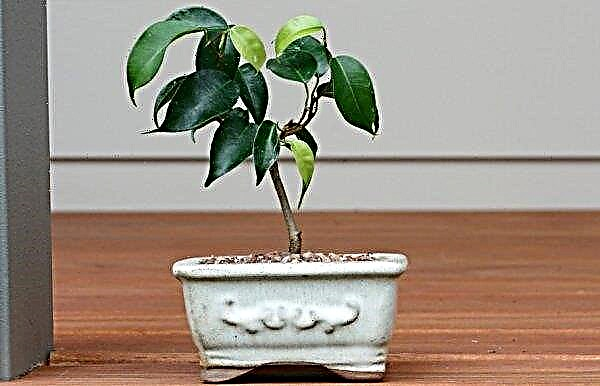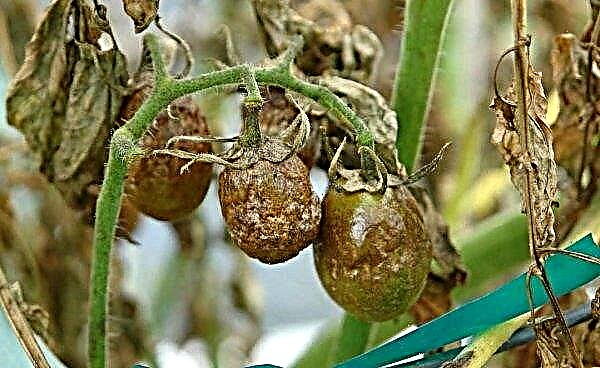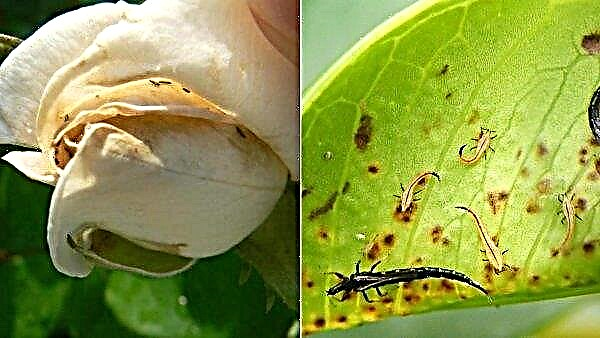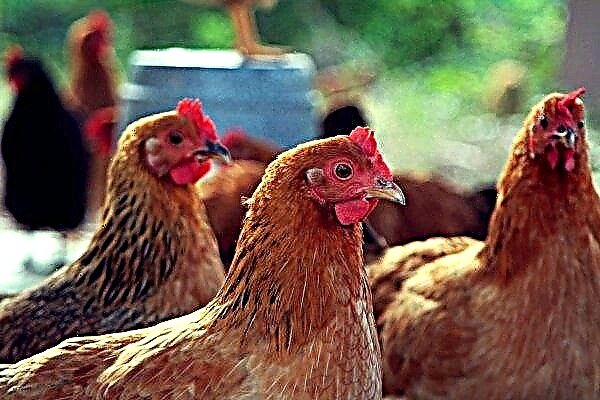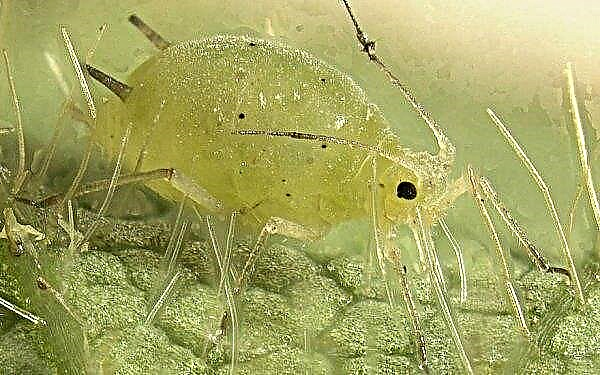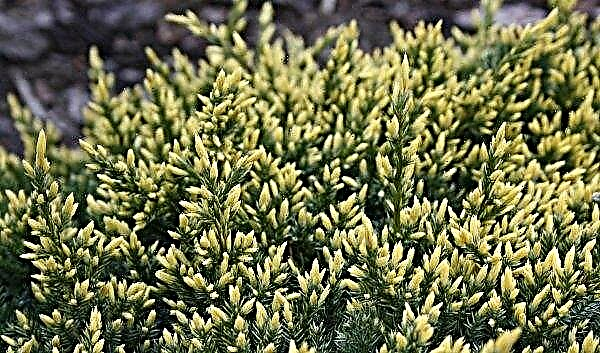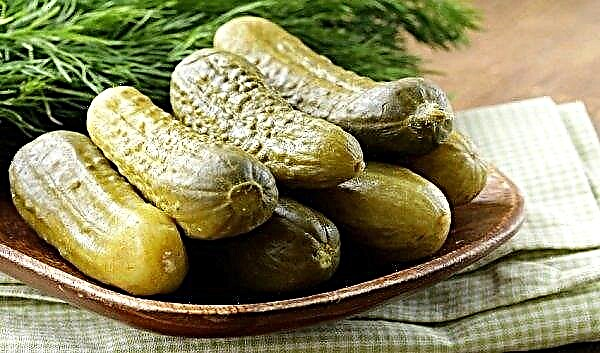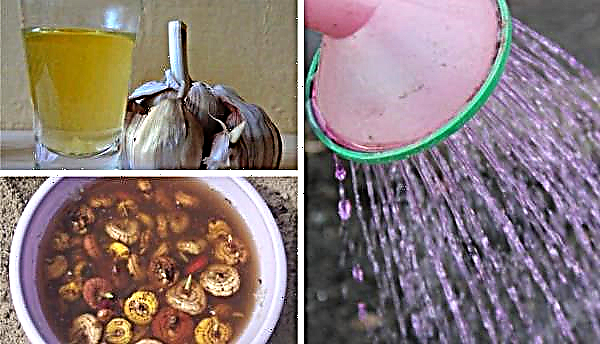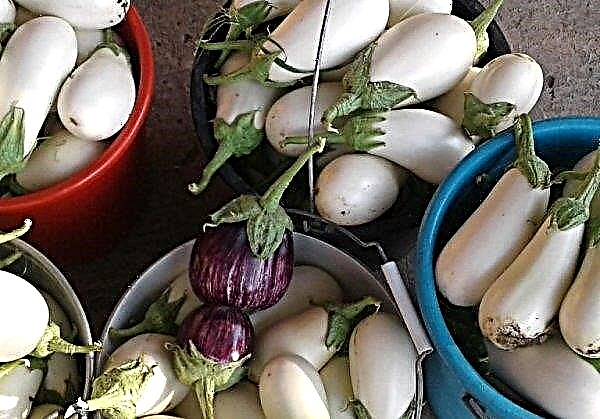There is hardly a lover of home plants whose collection does not have a single cactus: this popular plant is represented by such a wide range of varieties that it often becomes an object of collecting. Many varieties have a very original and unusual appearance, one of the most popular is Mikhanovich's hymnocalycium, which will be discussed later.
Botanical description of a houseplant
Gymnocalycium mihanovichii is a cactus of the genus Gymnocalicium. Argentina is considered to be the birthplace of the plant, although it is often found in other countries of South America.
Did you know? The name “hymnocalycium” can be translated from Greek as “bare cup”, which essentially describes the appearance of some subspecies of this genus, whose stems are not covered with thorns and have a cup-shaped shape.
The cactus has a slightly flattened spherical stem up to 5 cm high and up to 6 cm in diameter. The color of the stem is reddish-brown with large smooth ribs of a triangular section. On the ribs are gray-silver slightly curved spikes. Flowering plants usually occur when they reach two years of age or later. The process begins during the growing season, in the spring, and can last until the beginning of winter. Flowers with a diameter of about 3 cm appear on the top of the cactus, dissolving from the cups released by the plant.
Flowering plants usually occur when they reach two years of age or later. The process begins during the growing season, in the spring, and can last until the beginning of winter. Flowers with a diameter of about 3 cm appear on the top of the cactus, dissolving from the cups released by the plant.
The inflorescences are funnel-shaped (in the form of a bell), usually yellowish or pale pink.
Conditions for growing in the house
Growing Gymnocalycium mihanovichii is not difficult, if you rely on general recommendations for the content of cacti.
Placement and lighting
Gymnocalycium prefers bright, intense, but diffused light and does not tolerate direct sunlight. The scorching sun can provoke the appearance of burn spots on the surface of the stem.
The eastern or western windows of the apartment are considered the best place to place a flower pot; additional shading may be required on the south side and an artificial light source on the north side.
Important! Depending on the season, the cactus can be moved from one window to another, but you should not do this often and unnecessarily, as the plant experiences stress when adapting to new conditions.
Temperature mode
The gymnocalycium is unpretentious to temperature, it feels equally good in the range of + 15 ... + 30 ° C, provided that this temperature is constant. Sudden changes and drafts can be fatal to a flower. In winter, the plant stops its growth, and during this dormant period it is recommended to provide it with a stable cool air temperature of + 13 ... + 15 ° С.
In winter, the plant stops its growth, and during this dormant period it is recommended to provide it with a stable cool air temperature of + 13 ... + 15 ° С.
Air humidity
This variety, like other types of cactus, perfectly tolerates low humidity and does not require additional measures for moisturizing. On the contrary, spraying the stem can cause the flower to rot.
How to care for a plant at home
The process of caring for the hymnocalycium is simple and understandable even to beginner gardeners.
Did you know? It is no secret that cacti are drought tolerant - they provide themselves with a supply of moisture, accumulating it inside themselves. Thus, about 80% of the total mass of the plant is water.
Watering Rules
Perhaps the correct watering is the basis for the successful cultivation of cactus, so it is important to follow the general recommendations:
- water only with soft, settled or filtered water (the plant does not tolerate chlorine and hard water);
- let the soil in the pot dry completely between waterings;
- water under the root and prevent a large amount of water from getting on the plant stem;
- apply water at room temperature (not lower than + 18 ° C);
- use drainage to eliminate stagnation of water in the lower part of the pot;
- to regulate the intensity depending on the season: in summer, more frequent and plentiful watering, in autumn - twice less often, in winter the hymnocalycium does not need additional moisture at all until April.

Top dressing
A distinctive feature of the plant is its complete intolerance to organic fertilizers, so you can only feed cactus with mineral ones. It is better to use ready-made remedies for succulents and cacti, sold in flower shops, strictly following the instructions.
Fertilize the plant only during the growing season, that is, from April to the end of September, combining top dressing with watering once a month. In winter, while the flower is in hibernation, it does not need additional nutrients.
Transfer
Gymnocalycium grows very slowly, so often it is not necessary to transplant it. Transshipment of young plants is carried out once a year (in spring), then after the flower reaches the age of 3 years - once every 2-3 years as necessary.
In order to correctly perform the procedure of moving a flower into a new container, you need to proceed in stages:
- prepare a new pot - it should be slightly larger than the previous one;
- pull the plant out of the ground, remove damaged parts of the roots;
- rinse the root in water;
- allow the root system to dry for 2 days;
- to prepare a substrate of turf, sand, peat and deciduous mixture in equal proportions - it is recommended to use a ready-made purchased mixture for cacti;
- place a layer of drainage granules 1 cm thick on the bottom of the pot, then fill the tank with soil and plant a cactus in it;
- sprinkle with soil, compact, water the soil with soft water.

Reproduction of the hymnocalicium
The considered indoor plant propagates in two ways: vegetative and seed.
The vegetative method is considered the simplest and most effective; most of the processes take root quite quickly. The essence of the process is that the processes formed on the main stem are carefully cut and placed in a moistened peat-sand mixture.
Further care for children is carried out in the same way as for adult plants. Up to the moment of firm rooting, it is recommended to provide the shoot with support with the help of wooden toothpicks.
Important! When separating the processes, you need to try not to damage the main stem, as this can lead to infection.
The seed method is used extremely rarely due to the complexity of care, however, it is resorted to when breeding plants for sale, since cacti grown from seeds have a stronger immunity.
Seeds are sown in a flat container filled with moist cactus soil, and sprinkled on top with an additional thin layer. The pot is installed in a place with a stable temperature and the substrate is regularly sprayed to prevent it from drying out.
The first shoots usually appear after 10-12 days. The young hymnocalicium is transferred to a permanent habitat upon reaching one year of age.
Growing difficulties
Despite the unpretentious nature of the hymnocalicium, flower growers often encounter problems when growing it. Usually they are caused by a violation of the rules for keeping a flower or a defeat by disease.
Diseases
The gymnocalycium is highly resistant to disease, but it may develop root rot, which can lead to the death of the plant. This is usually caused by overflowing or planting in an excessively fertile substrate.
You can cope with the disease by removing the affected processes of the root system, after which the remaining roots are washed with water and treated with a fungicidal agent (for example, "Practician").
Pests
This type of cactus is characterized by infection with some specific pests:
Prevention will help to avoid troubles when growing a hymnocalicium:
- the use of special soil for cacti;
- proper organization of irrigation (it is important to prevent stagnation of water and waterlogging of the soil);
- drainage application;
- watering the flower only with soft, settled water to prevent soil alkalization.
So, having examined the characteristics and features of the Mikhanovich Calcium, we can conclude that this plant is ideal for home cultivation due to its unpretentiousness. The cactus not only takes root well and quickly multiplies, but also regularly pleases with long flowering, subject to the rules for caring for it.

